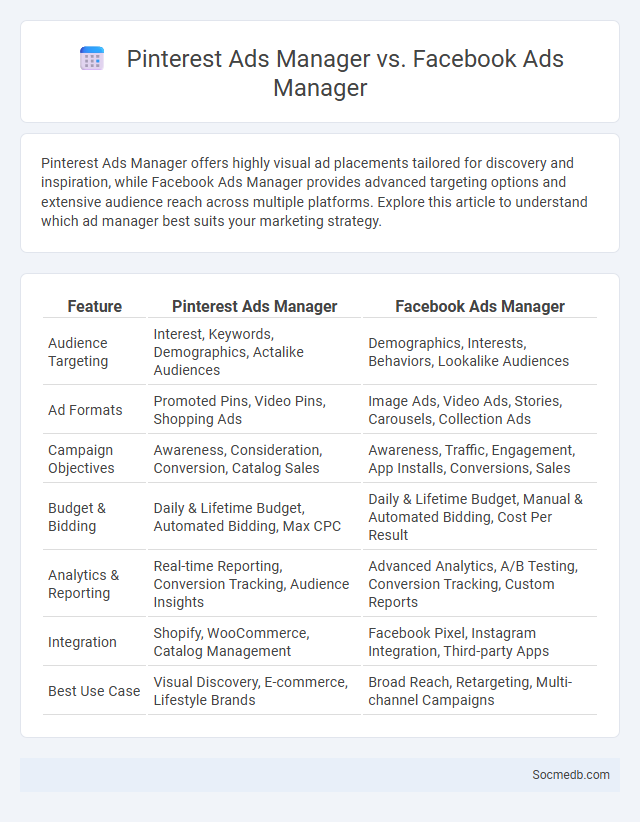
Photo illustration: Pinterest Ads Manager vs Facebook Ads Manager
Pinterest Ads Manager offers highly visual ad placements tailored for discovery and inspiration, while Facebook Ads Manager provides advanced targeting options and extensive audience reach across multiple platforms. Explore this article to understand which ad manager best suits your marketing strategy.
Table of Comparison
| Feature | Pinterest Ads Manager | Facebook Ads Manager |
|---|---|---|
| Audience Targeting | Interest, Keywords, Demographics, Actalike Audiences | Demographics, Interests, Behaviors, Lookalike Audiences |
| Ad Formats | Promoted Pins, Video Pins, Shopping Ads | Image Ads, Video Ads, Stories, Carousels, Collection Ads |
| Campaign Objectives | Awareness, Consideration, Conversion, Catalog Sales | Awareness, Traffic, Engagement, App Installs, Conversions, Sales |
| Budget & Bidding | Daily & Lifetime Budget, Automated Bidding, Max CPC | Daily & Lifetime Budget, Manual & Automated Bidding, Cost Per Result |
| Analytics & Reporting | Real-time Reporting, Conversion Tracking, Audience Insights | Advanced Analytics, A/B Testing, Conversion Tracking, Custom Reports |
| Integration | Shopify, WooCommerce, Catalog Management | Facebook Pixel, Instagram Integration, Third-party Apps |
| Best Use Case | Visual Discovery, E-commerce, Lifestyle Brands | Broad Reach, Retargeting, Multi-channel Campaigns |
Overview of Pinterest Ads Manager
Pinterest Ads Manager offers a powerful platform for businesses to create, manage, and analyze targeted advertising campaigns. You can leverage detailed audience insights and flexible ad formats to boost brand visibility and drive conversions. The intuitive dashboard streamlines campaign tracking, enabling data-driven decisions to optimize your marketing strategy effectively.
Key Features of Facebook Ads Manager
Facebook Ads Manager offers You a comprehensive platform to create, manage, and analyze ad campaigns across Facebook, Instagram, and Messenger. Key features include detailed audience targeting, budget control, performance tracking with real-time analytics, and A/B testing to optimize ad effectiveness. The tool also supports customizable ad formats and scheduling options, enhancing Your ability to reach and engage specific customer segments efficiently.
Understanding Paid Promotion Across Platforms
Paid promotion on social media involves strategically using advertising budgets to boost content visibility and engagement across platforms like Facebook, Instagram, Twitter, and LinkedIn. Understanding platform-specific targeting options, such as audience demographics, interests, and behaviors, enhances campaign effectiveness and ROI. Analyzing metrics like click-through rates, conversion rates, and cost-per-click helps optimize ad performance and maximize business outcomes.
Audience Targeting Capabilities
Social media platforms offer advanced audience targeting capabilities that allow you to reach specific demographic groups based on age, location, interests, and behavior. Using data-driven algorithms, advertisers can fine-tune campaigns to maximize engagement and conversion rates efficiently. These precise targeting tools increase the relevance of your content, ensuring it reaches users most likely to interact with your brand.
Ad Format Options and Creative Tools
Social media platforms offer diverse ad format options including image ads, video ads, carousel ads, and story ads, designed to capture user attention and drive engagement. Advanced creative tools enable advertisers to customize visuals, incorporate interactive elements, and optimize content for mobile and desktop devices. Leveraging these formats and tools maximizes brand visibility and enhances conversion rates across Facebook, Instagram, LinkedIn, and TikTok campaigns.
Budgeting and Bidding Strategies
Effective budgeting and bidding strategies on social media platforms maximize ad spend efficiency by targeting specific audiences and optimizing cost-per-click (CPC) or cost-per-impression (CPM) metrics. Utilizing techniques such as daily or lifetime budgets, manual bidding, and automated bidding algorithms allows marketers to control costs while achieving desired engagement and conversion goals. Continuous monitoring and adjustment of bids based on performance analytics ensure sustainable campaign growth and higher return on investment (ROI).
Analytics and Performance Tracking
Social media analytics tools collect and interpret data to measure user engagement, reach, and conversion rates across platforms like Facebook, Instagram, and Twitter. Key performance indicators such as click-through rates, follower growth, and sentiment analysis enable businesses to optimize content strategies for higher ROI. Real-time dashboards and detailed reports facilitate data-driven decisions that enhance targeting precision and campaign effectiveness.
User Experience and Ease of Use
Social media platforms prioritize user experience by incorporating intuitive navigation, personalized content feeds, and seamless interaction features to enhance engagement. Ease of use is achieved through streamlined interfaces, quick loading times, and accessible design that accommodates diverse device types and user capabilities. Continuous improvements in algorithms and user feedback integration optimize overall satisfaction and retention on major social media networks.
Platform Suitability for Different Businesses
Selecting the right social media platform is crucial for business success, as each platform caters to different audience demographics and content types. Instagram and Pinterest excel for visually-driven brands like fashion and food, while LinkedIn targets B2B companies seeking professional networking and lead generation. Facebook and TikTok offer broad reach and engagement, making them ideal for consumer-focused businesses aiming to build community and brand awareness.
Choosing the Best Ad Platform for Your Goals
Selecting the best ad platform for your social media marketing depends on your target audience, campaign objectives, and budget. Facebook Ads provide extensive targeting options ideal for brand awareness and lead generation, while LinkedIn Ads excel in B2B marketing and professional audience engagement. Analyzing platform demographics and ad performance metrics ensures alignment with your business goals for maximum return on investment.
 socmedb.com
socmedb.com